Magento Ecommerce (aka Adobe Commerce) in 2025: What to Know Before You Commit

Magento eCommerce (now Adobe Commerce) is still one of the most flexible eCommerce platforms out there—but it’s not for everyone. It’s powerful, scalable, and developer-friendly… which is also a polite way of saying it can be a headache if you’re not prepared.
In this guide, we’ll walk through what makes Magento great, what challenges you’ll face, and how to know if it’s the right fit for your B2B ecommerce strategy in 2025.
A History of Magento Commerce Cloud
To succeed in ecommerce, you need agile tools and robust platforms. The Magento platform has provided these things to customers for many years. Let’s take a quick look at how Magento started, developed to meet customer needs, and finally, became part of Adobe’s portfolio.
Magento 1
Let’s go back in time…
The year is 2008 and you want to start an online store. There’s just one problem: most ecommerce platforms are limited. And none of them offer detailed customization options.
Then Magento hits the market and a whole new world of possibilities opens up to you. After all, Magento is built with open-source technology, so it will allow your business to really tailor its online store front to suit your individual needs and preferences. Win!
Features of Magento 1:
- Customizability: From UI to checkout processes, everything could be molded to fit a brand’s distinct style. Digital retailers could finally stand out from the crowd.
- Community Support: Developers worldwide contributed to the platform, which enabled Magento to create a rich library of plugins and extensions for its customers.
- Scalability: Magento was designed to grow with businesses. As such, it supported small and large enterprises alike, helping all users connect with their customers.
It wasn’t all rainbows and sunshine, though. Despite its top-level features, Magento was hard to use. This was especially true for small companies without dedicated IT teams.
Drawbacks of Magento 1:
- Steep Learning Curve: New users found it challenging to navigate Magento and build their online stores. Fully customizable? Yes. Easily customizable? Sadly, no.
- Performance Issues: A ton of companies built themselves a Magento website, which bogged down the platform. Because of this, performance lags were common.
- Security Concerns: Regular patches were necessary to keep vulnerabilities at bay. Basically, if you had a Magento site, your ecommerce store was harder to secure.
Magento 2
Magento 2 was unveiled in 2015. But it wasn’t just an update, it was a complete overhaul of the platform. This transition marked a significant leap in ecommerce technology.
Features of Magento 2:
- Improved Performance: Every Magento store enjoyed faster page load times and more efficient transactions. These things had a huge impact on the user experience.
- Streamlined Checkout: Magento 2 also simplified the checkout process. This helped reduce cart abandonment rates and allowed ecommerce stores to increase revenue.
- Mobile-Friendly Design: Also of note, Magento 2 catered to mobile users—a growing segment of the population—by offering responsive storefront designs.
Despite the upgrades, Magento 2 had its own set of challenges. For example, compatibility with old Magento ecommerce extensions was a real challenge that retailers had to overcome.
Drawbacks of Magento 2:
- Migration Difficulties: Transitioning from Magento 1 to Magento 2 was anything but straightforward. The process usually requires significant effort and planning.
- Platform Costs: Magento pricing became an issue for some customers. Yes, the company still offered a free, open-source tool. But hosting and development fees could be high. Also, to access advanced features, users had to pay a monthly subscription.
- Complexity: While Magento 2 was easier to use than Magento 1, it still wasn’t a very user-friendly platform. As such, advanced technical expertise was still required.
Adobe Commerce
Industry titan, Adobe, acquired the entire Magento enterprise in 2018. This acquisition paved the way for Adobe Commerce, which offers a comprehensive suite of ecommerce tools.
One of the biggest benefits of Adobe Commerce is the fact that Magento software now enjoys a seamless connection with other Adobe services. This enhances both user experience and operational efficiency. (Though it’s not a perfect solution, as we’ll soon see.)
Now that we’ve covered the history of Magento Ecommerce, let’s talk about what the software’s current iteration, Adobe Commerce, can actually do for online retailers!
Adobe Commerce: Features, Drawbacks and Other Details
We’ll be honest: there are a bunch of ecommerce platforms on the market. But Adobe Commerce stands out for its comprehensive suite of features designed to streamline operations, boost sales, and enhance the customer experience. Let’s talk more about that…
Adobe Commerce Features
Adobe Commerce is a top contender in the ecommerce platform space. Why? Because the tool is packed with a variety of features that will help improve the way businesses operate online.
Whether you’re seeking seamless shopping experiences, innovative management tools, or scalable solutions, Adobe Commerce has something to offer. In this section, we’ll look at the Adobe Commerce feature set to see if it has the firepower your ecommerce business needs.
Sell Anywhere
With Adobe Commerce, customers can shop whenever and wherever they choose. This is important because modern consumers demand options that fit their personal lifestyles.
Adobe Commerce allows users to create a dynamic, multi-channel shopping experience that caters to different audiences across different platforms and devices. This allows businesses to remain accessible and customer-friendly, no matter where a customer happens to be.
Key capabilities include:
- Responsive designs that adapts to all devices
- Integration with various sales channels to meet customers where they are
- Consistent experience to ensure smooth transitions across different platforms
Manage and Deliver
Adobe Commerce also helps users fine-tune the shopping and purchasing experience—at scale. With its robust features, businesses can customize and manage everything from inventory to delivery processes to personalize the customer’s purchase journey.
Key capabilities include:
- Flexible inventory management options to simplify business operations
- Customer personalization tools to tailor the buyer experience based on behavior
- A CMS to create and publish compelling content for almost any ecommerce website
Measure and Optimize
You can’t optimize the customer experience without detailed analytics. Adobe Commerce gives users real-time data, so they can measure performance and enhance the buyer’s time on site.
Key capabilities include:
- Data-driven insights to understand buying behaviors
- Real-time analytics to make better decisions in less time
- Tools to visualize and report on the data your online store collects
Scale, Extend, and Support
Last but not least, Adobe Commerce helps companies scale and innovate—without compromising security. If you’re looking to serve more customers, drive more revenue, and otherwise expand your business, Adobe’s scalability potential is a feather in its cap.
Key capabilities include:
- Advanced security features that protect sensitive data from cybercriminals
- The Adobe (Magento) marketplace offers plenty of Adobe (Magento) extensions that customers can use to customize and improve their digital storefronts
- Scalable infrastructure to easily handle increased traffic, orders, and general demand
Adobe Commerce Drawbacks
As we’ve just seen, Adobe Commerce is a capable ecommerce platform. But much like Magento ecommerce, the software Adobe acquired in 2018, Adobe Commerce is far from perfect.
So, in this section we’ll look at the drawbacks of Adobe Commerce. That way you can make an informed decision about whether this tool is right for your business.
Learning Curve
Adobe Commerce is a powerful tool, but it comes with a steep learning curve. This can be a hurdle for newcomers to the platform—especially those that lack technical expertise.
If you invest in Adobe Commerce, budget a significant amount of time and resources to learn how it works. That way you can access and use the tool’s extensive feature set. There’s no point in paying for an extensive piece of software if you can’t actually use it.
Ongoing Complexity
Time and training will help you learn about and use Adobe / Magento Commerce. But that doesn’t mean you’ll have zero issues after onboarding. In fact, you’ll almost certainly run into problems.
Adobe Commerce requires technical knowledge to operate on a daily basis. Because of this, users often find it more cumbersome than alternative platforms.
Before you purchase Adobe Commerce ask yourself, “Do I feel comfortable using complex software?” And, “Are the advantages of Adobe Commerce worth the extra time and effort needed to use the tool?” Then answer both questions honestly to assess this app’s merits.
Higher Costs
Finally, Adobe Commerce is often more expensive than other ecommerce platforms.
Yes, the platform includes a swath of impressive features. But this doesn’t matter much if your business can’t afford the initial setup and maintenance fees that Adobe Commerce requires.
Weigh the financial implications of using Adobe Commerce before you commit to the tool. The platform might be out of reach for small ecommerce brands with tight budgets.
Adobe Commerce Pricing Plans
Let’s talk more about the cost of Adobe Commerce…
Adobe doesn’t actually post prices on its website. That’s because the Adobe team assesses every customer and offers them a customized price based on their unique needs.
That said, there are a couple of things we do know about Adobe’s pricing model. For example, Adobe offers two packages: Commerce Pro and Managed Services.
- Commerce Pro: Access to the Adobe Commerce platform and a variety of important features that include customization options, enhanced security, and more.
- Managed Services: Access to everything in the Commerce Pro package, plus additional support options that increase usability and integration with other Adobe tools.
To learn exactly what Adobe Commerce will cost your business, contact Adobe directly.
Experlogix Digital Commerce: A Viable Alternative to Magento eCommerce
Adobe Commerce isn’t the right tool for every ecommerce company. If you’re worried about the steep learning curve, ongoing complexity, or price, allow us to introduce you to Experlogix.
The Experlogix Digital Commerce platform combines ease of use with powerful features. The result? An industry-leading tool for ecommerce businesses in a variety of industries.
Let’s take a look at what Experlogix Digital Commerce has to offer your online store:
Key Features of Experlogix Digital Commerce
Experlogix stands out with a suite of quality features—each designed to meet a range of modern business needs. Here are the highlights you should know about:
- A User-Friendly Interface: Unlike some complex platforms, Experlogix prides itself on being straightforward and intuitive. In a world where time is money, having a system that’s easy to navigate can save ecommerce businesses countless hours.
- Customization and Flexibility: At Experlogix, we believe your ecommerce platform should fit your business perfectly—kind of like a tailored suit. Our solution is fully customizable and can adapt to various industries and business types. This flexibility makes sure your specific business needs are met with ease and speed.
- Seamless Integration Options: In all likelihood, you use multiple software applications to run your ecommerce business. For example, you might use CRM or ERP software to track customers and sales. With Experlogix, you can integrate your CRM or ERP with your ecommerce platform to increase productivity, accuracy, and results.
- Fast Deployment and Maintenance: Setting up an ecommerce site shouldn’t feel like building a skyscraper. Experlogix is designed for quick deployment, allowing businesses to get up and running in as little time as possible. Plus, you won’t have to worry about cumbersome maintenance routines that lead to website downtime.
Comparing Experlogix with Adobe Commerce
So, how does Experlogix measure up against Adobe Commerce? There are three main differences you need to understand. Once you do, the choice between them will be easy:
- Simplicity vs. Complexity: Adobe Commerce is known for its comprehensive features, but this can sometimes affect the tool’s usability. Experlogix offers a more streamlined experience, which makes it a better fit for businesses that prioritize ease of use.
- Different Business Applications: Experlogix Digital Commerce was built to assist B2B businesses. Adobe Commerce, on the other hand, serves B2B and B2C customers equally well. Keep this in mind when choosing between the two tools.
- Integration Capabilities: Both platforms support integration, but Experlogix is often praised for its ability to connect to CRM and ERP software. This is especially important for customers in the distribution and wholesale industries, in which Experlogix excels.
Both Adobe Commerce and Experlogix Digital Commerce will help you build and manage a stellar ecommerce website. You just need to determine which one fits your business best.
We’ll make it easy for you: if you’re in the B2B space and want to streamline business operations in as little time as possible, choose Experlogix. But if you’re in the B2C space, or run a large B2B ecommerce business with a dedicated IT team, consider Adobe Commerce / Magento ecommerce.
If your ecommerce stack feels too dev-heavy or hard to update, this is your way out. Our no-code tools help B2B sellers move fast without breaking things.
Is Adobe Commerce Right for Your Company?
Adobe Commerce is one of the more popular ecommerce platforms on the market.
It’s easy to see why. The tool is highly customizable, offers a ton of features you can use to elevate the customer experience, and will grow with your company in the future.
That said, the complexity and cost to maintain an Adobe Commerce website is worth considering. Some businesses might lack the technical expertise to make Adobe Commerce a viable option. Others might decide to avoid the potential headache and pick a different tool.
We can’t tell you which ecommerce platform is right for your business. But we can give you an insider look at Experlogix Digital Commerce, a top competitor to Adobe Commerce.
Sign up for a free demo of our tool today to see if it meets all of your ecommerce needs!
Adobe and Magento Commerce FAQs
Is Magento the Same as Shopify?
Magento and Shopify are both popular ecommerce tools. To clarify, they are not the same. Though, to be fair, both serve the same purpose—helping ecommerce businesses sell online.
Here are a few key differences between these two ecommerce website solutions…
Magento:
- A flexible tool that offers users a ton of customization options
- Due to its customizability, Magento requires significant technical expertise
- As such, Magento is best for companies with complex needs and large budgets
Shopify:
- A straightforward tool that’s known for its easy-to-use features
- This level of simplicity makes Shopify ideal for B2C brands, not B2B brands
- Millions of small to medium-sized businesses use Shopify to sell to customers
In essence, Magento is a great choice for businesses looking for deep control over their store’s features, while Shopify excels in simplicity and speed of launch.
Is Magento Owned by Adobe?
Long story short, yes, Magento is owned by Adobe.
Magento was originally introduced to the world in 2008. Over the next decade, the platform went through multiple changes and iterations. Then, in 2018, the Magento developers sold their application to Adobe, who eventually integrated the tool into its Experience Cloud product.
Now, Magento is known as Adobe Commerce and serves a variety of ecommerce businesses in both B2B and B2C markets. The article above compares and reviews Adobe Commerce.
Is Magento Ecommerce Free?
The answer to that question is… It depends.
Magento Open Source is free to download and use. (Though, to be clear, you’ll still need to invest in hosting, security, and development costs to build a fully functional site.) It’s a solid option for companies that have the resources to manage these aspects independently.
Adobe Commerce, which grew out of Magento Commerce when Adobe acquired the platform, is not free to download and use. This cloud-based solution offers advanced features for marketing, selling, and otherwise growing an ecommerce business. It also comes with in-depth support options, which could definitely come in handy given the platform’s complexity.
Who Should Use Adobe Commerce?
As we discussed in the article above, Adobe Commerce is a powerful tool. But it’s not the best option for every ecommerce website because of its complexity and cost.
So, you’re probably wondering, “Who should use Adobe Commerce?” Here’s our take:
- Large enterprises that need custom solutions and sell numerous products
- Medium-sized businesses that need extensive functionalities in order to scale
- Tech-savvy teams that are able and willing to deal with Adobe’s many complexities
- Brands that want to integrate with Adobe’s other tools for a holistic digital experience
Final Thoughts
While Adobe Commerce offers a robust set of features, it may not be the right fit for every ecommerce business. If you’re looking for a more streamlined solution with powerful integration capabilities, consider Experlogix Digital Commerce. Our platform is designed to help you scale effortlessly and simplify your ecommerce operations.
Ready to explore your options? Contact us today to schedule a demo and see how Experlogix can help you unlock better ecommerce performance faster.



